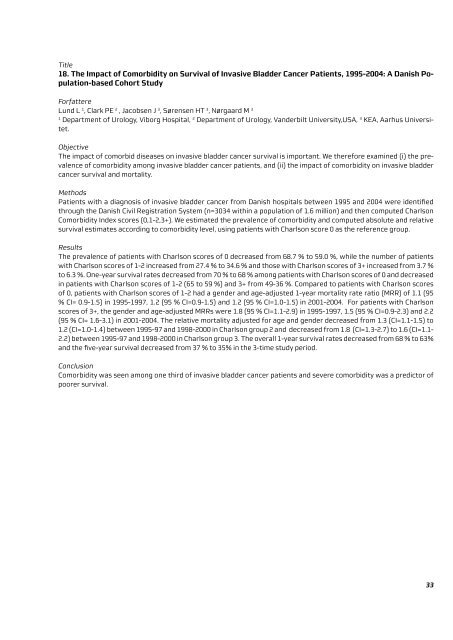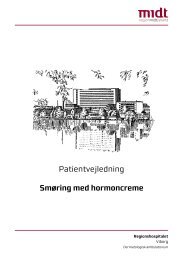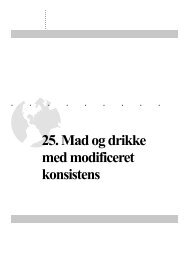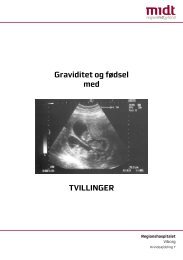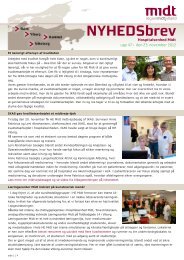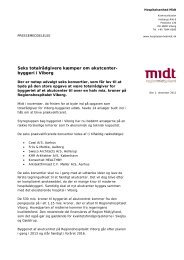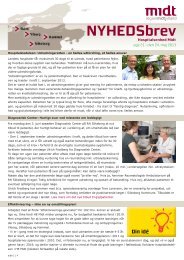Forskningensdag2009 abstracts - Hospitalsenhed Midt
Forskningensdag2009 abstracts - Hospitalsenhed Midt
Forskningensdag2009 abstracts - Hospitalsenhed Midt
Create successful ePaper yourself
Turn your PDF publications into a flip-book with our unique Google optimized e-Paper software.
Title<br />
18. the impact of comorbidity on Survival of invasive bladder cancer Patients, 1995-2004: a danish Population-based<br />
cohort Study<br />
Forfattere<br />
Lund L 1 , Clark PE 2 , Jacobsen J 3 , Sørensen HT 3 , Nørgaard M 3<br />
1 2 3 Department of Urology, Viborg Hospital, Department of Urology, Vanderbilt University,USA, KEA, Aarhus Universitet.<br />
Objective<br />
The impact of comorbid diseases on invasive bladder cancer survival is important. We therefore examined (i) the prevalence<br />
of comorbidity among invasive bladder cancer patients, and (ii) the impact of comorbidity on invasive bladder<br />
cancer survival and mortality.<br />
Methods<br />
Patients with a diagnosis of invasive bladder cancer from Danish hospitals between 1995 and 2004 were identified<br />
through the Danish Civil Registration System (n=3034 within a population of 1.6 million) and then computed Charlson<br />
Comorbidity Index scores (0,1-2,3+). We estimated the prevalence of comorbidity and computed absolute and relative<br />
survival estimates according to comorbidity level, using patients with Charlson score 0 as the reference group.<br />
Results<br />
The prevalence of patients with Charlson scores of 0 decreased from 68.7 % to 59.0 %, while the number of patients<br />
with Charlson scores of 1-2 increased from 27.4 % to 34.6 % and those with Charlson scores of 3+ increased from 3.7 %<br />
to 6.3 %. One-year survival rates decreased from 70 % to 68 % among patients with Charlson scores of 0 and decreased<br />
in patients with Charlson scores of 1-2 (65 to 59 %) and 3+ from 49-36 %. Compared to patients with Charlson scores<br />
of 0, patients with Charlson scores of 1-2 had a gender and age-adjusted 1-year mortality rate ratio (MRR) of 1.1 (95<br />
% CI= 0.9-1.5) in 1995-1997, 1.2 (95 % CI=0.9-1.5) and 1.2 (95 % CI=1.0-1.5) in 2001-2004. For patients with Charlson<br />
scores of 3+, the gender and age-adjusted MRRs were 1.8 (95 % CI=1.1-2.9) in 1995-1997, 1.5 (95 % CI=0.9-2.3) and 2.2<br />
(95 % CI= 1.6-3.1) in 2001-2004. The relative mortality adjusted for age and gender decreased from 1.3 (CI=1.1-1.5) to<br />
1.2 (CI=1.0-1.4) between 1995-97 and 1998-2000 in Charlson group 2 and decreased from 1.8 (CI=1.3-2.7) to 1.6 (CI=1.1-<br />
2.2) between 1995-97 and 1998-2000 in Charlson group 3. The overall 1-year survival rates decreased from 68 % to 63%<br />
and the five-year survival decreased from 37 % to 35% in the 3-time study period.<br />
Conclusion<br />
Comorbidity was seen among one third of invasive bladder cancer patients and severe comorbidity was a predictor of<br />
poorer survival.<br />
33


